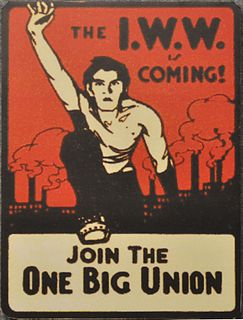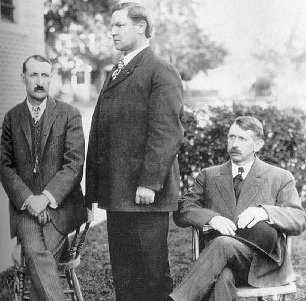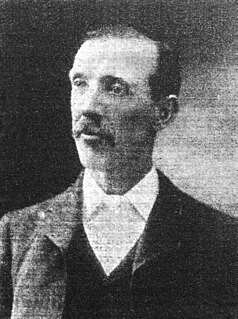
The One Big Union was an idea in the late 19th and early 20th centuries amongst trade unionists to unite the interests of workers and offer solutions to all labour problems.
There were two related incidents between miners and mine owners in the Coeur d'Alene Mining District of North Idaho: the Coeur d'Alene, Idaho labor strike of 1892, and the Coeur d'Alene, Idaho labor confrontation of 1899. This article is a brief overview of both events.

Charles H. "Charlie" Moyer was an American labor leader and president of the Western Federation of Miners (WFM) from 1902 to 1926. He led the union through the Colorado Labor Wars, was accused of murdering an ex-governor of the state of Idaho, and was shot in the back during a bitter copper mine strike. He also was a leading force in founding the Industrial Workers of the World, although he later denounced the organization.

Edward "Ed" Boyce was president of the Western Federation of Miners, a radical American labor organizer, socialist and hard rock mine owner.

The Cripple Creek miners' strike of 1894 was a five-month strike by the Western Federation of Miners (WFM) in Cripple Creek, Colorado, USA. It resulted in a victory for the union and was followed in 1903 by the Colorado Labor Wars. It is notable for being the only time in United States history when a state militia was called out in support of striking workers.
Eben Smith was a successful mine owner, smelting company executive, railroad executive and bank owner in Colorado in the late 19th century and early 20th century.
Labor federation competition in the United States is a history of the labor movement, considering U.S. labor organizations and federations that have been regional, national, or international in scope, and that have united organizations of disparate groups of workers. Union philosophy and ideology changed from one period to another, conflicting at times. Government actions have controlled, or legislated against particular industrial actions or labor entities, resulting in the diminishing of one labor federation entity or the advance of another.

The American Labor Union (ALU) was a radical labor organization launched as the Western Labor Union (WLU) in 1898. The organization was established by the Western Federation of Miners (WFM) in an effort to build a federation of trade unions in the aftermath of the failed Leadville Miners' Strike of 1896. The group changed its name from WLU to the more familiar ALU moniker in 1902 at its fifth annual convention. The group had a peak membership of about 43,000 — of which 27,000 were members of the WFM. The ALU was a precursor to the Industrial Workers of the World (IWW), established in 1905, which effectively terminated it.

The Colorado labor wars were a series of labor strikes in 1903 and 1904 in the US state of Colorado, by gold and silver miners and mill workers represented by the Western Federation of Miners (WFM). Opposing the WFM were associations of mine owners and businessmen at each location, supported by the Colorado state government. The strikes were notable and controversial for the accompanying violence, and the imposition of martial law by the Colorado National Guard in order to put down the strikes.
The Leadville miners' strike was a labor action by the Cloud City Miners' Union, which was the Leadville, Colorado local of the Western Federation of Miners (WFM), against those silver mines paying less than $3.00 per day. The strike lasted from 19 June 1896 to 9 March 1897, and resulted in a major defeat for the union, largely due to the unified opposition of the mine owners. The failure of the strike caused the WFM to leave the American Federation of Labor (AFL), and is regarded as a cause for the WFM turn toward revolutionary socialism.
Hard rock miners' organizations have included fraternal and union organization of miners or mine workers formed for the purpose of addressing issues such as wages, health and safety, funeral arrangements of members, or widow's benefits. Fraternal organizations have tended to focus on welfare and community; union organizations and federations have included economic issues and negotiations with employers.
John Francis Campion was the wealthy owner of several hard rock mines in the Leadville, Colorado area. After 1900, he made a second fortune growing sugar beets. The community of Campion, Colorado is named after him. Campion is a somewhat obscure figure today, but was well known in his day. His big gold strike at the Little Jonny Mine in Leadville made him and his partners rich. He had help engineering the dig from James J. Brown, whose wife Margaret "Molly" Brown won fame in the sinking of the great liner Titanic. Campion was partnered with industrialist Charles Boettcher in ventures including mining in Leadville, the formation of the Great Western Sugar Company and the co-founding of the Ideal Cement Company. Campion was also an owner of the Leadville Light and Power Company and the Western Meat Packing Company, and once owned the Herald-Democrat newspaper.

The Coeur d'Alene, Idaho, labor strike of 1892 erupted in violence when labor union miners discovered they had been infiltrated by a Pinkerton agent who had routinely provided union information to the mine owners. The response to that violence, disastrous for the local miners' union, became the primary motivation for the formation of the Western Federation of Miners (WFM) the following year.
In the United States shortly after 1900, there were few effective employers' organizations that opposed the union movement. By 1903, these organizations started to coalesce, and a national employers' movement began to exert a powerful influence on industrial relations and public affairs.

The Butte Miners' Union, formerly known as the Butte Workingmen's Union, was formed in 1878 as a reaction to working conditions in the mines of Butte, Montana.
The Idaho Springs miners strike of 1903 was a labor strike by members of the Western Federation of Miners (WFM) against gold mines in the vicinity of Idaho Springs, Colorado. It is one of the strikes of 1903-1904 that are collectively known as the Colorado Labor Wars. The union demanded a reduction in the working day to eight hours, without a corresponding reduction in pay. The strike began on 1 May 1903, and was called off on 1 September 1903. The strike is noted for a dynamite attack on the Sun and Moon mine, and the forcible deportation of 19 union officials and union members from the area.

The Butte, Montana labor riots of 1914 were a series of violent clashes between copper miners at Butte, Montana. The opposing factions were the miners dissatisfied with the Western Federation of Miners local at Butte, on the one hand, and those loyal to the union local on the other. The dissident miners formed a new union, and demanded that all miners join the new union, or be subject to beatings or forced expulsion from the area. Sources disagree whether the dissidents were a majority of the miners, or a militant minority. The leadership of the new union contained many who were members of the Industrial Workers of the World (I.W.W.), or agreed with the I.W.W.'s methods and objectives. The result of the dispute between rival unions was that the copper mines of Butte, which had long been a union stronghold for the WFM, became open shop employers, and recognized no union from 1914 until 1934.

Butte is a city in southwestern Montana established as a mining camp in the 1860s in the northern Rocky Mountains straddling the Continental Divide. Butte became a hotbed for silver and gold mining in its early stages, and grew exponentially upon the advent of electricity in the late-nineteenth century due to the land's large natural stores of copper. In 1888 alone, mining operations in Butte had generated an output of $23 million. The arrival of several magnates in the area around this time, later known as the "Copper Kings," marked the beginning of Butte's establishment as a boomtown.














